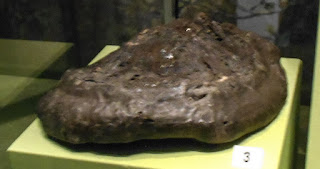I'd heard lots of hype about the upcoming Stonehenge exhibition during the latter part of last year, but decided to hang fire before booking as I wanted to find out if it was worth the trip first [you know that good old delay and pay thrifty technique to check that we really want to do/own something]. Once it had opened it began to receive rave reviews and a friend who'd been came back with a glowing report too. Knowing how serendipity works, Lovely Grey popped up with it as a suggestion for our upcoming meet-up....once I'd got wind of some of the big hitters on display [things I've always wanted to see] I didn't need to be asked twice. Now my lovely pal has been far more organised than me [for personal reasons I'm doing things at a pace that suits my current situation] and has written a fabulous post about it already https://lovelygreyday.com/british-museum-the-world-of-stonehenge/
Here's my offering....better late than never eh! I've tried to include a real cross section to give a flavour of what's shown and any write-up surely should include the German Nebra sky disc. I remember this being rescued from sale on the black market after it was illegally dug up by a night hawk. Thank goodness it was intercepted otherwise it would probably have disappeared into a private collection somewhere and remain unknown. It's the oldest known depiction of the cosmos and shows that even back then people were trading as the gold on it comes from Cornwall.
Another of the big hitters on display is the Folkton drums. Touchingly some of these chalk cylindrical objects were found in a child's grave. Their purpose is unknown, but one theory was that if cord was wrapped round them they could be used as a type of measuring device.
Equally mysterious are these carved stone balls which mainly come from Scotland. The latest "Digging for Britain" series. showed some new ones being excavated last summer. Some of the patterns are very intricate whilst others seem to have been left unfinished [perhaps deliberately or maybe people just gave up on their artistic endeavours...a stoneage equivalent of an Un.Finished.Object or UFO so common in craft project parlance!]. We were lucky enough to see several on Orkney a few years ago. I love the fact that it demonstrates that folks had time to be creative.
I have been intrigued by stone tools for a long time. There were some beautiful ones on display where people went to tremendous trouble to source unusual stones from inaccessible places. We know that some were just for prestige [bit like the Rolex watch of their day maybe?!] and wouldn't have been any use as real tools. Some fabulous alternative axe head shapes shown and even after they'd had their day people still valued them thousands of years later. There have been axe heads found in much later graves and some referred to them as thunderstones http://gnatbottomedtowers.blogspot.com/search?q=thunderstones The one which has been set in silver was worn in the 1800s as an amulet to protect against kidney disease. However, it's the one with the preserved wooden handle found in a Scottish peat bog that really caught my eye. It's only by chance it's survived, but it immediately gives me that window into the past to show how it was used when it was first made. The stone in it has come from Ireland
Talking of stones if it's that you're wanting then there's several big uns to choose from. The one shown here is from the Alps and if you look closely you can make out the sun and depictions of wild animals. Obviously bringing Stonehenge itself could have proved a tad tricky, but the wooden Seahenge is there in all its glory.
There's a lot of bling to be seen with cases full of gold objects and impressive bits of statement jewellery. Coming in at 90cm tall if you were wearing the Schifferstadt hat you would either have to remain standing or sitting I would imagine so that it didn't fall off! What was certain was that you were definitely going to make an impression! It was most probably worn by a shamanic figure and the patterns are thought to be connected to solar worship.
One of the items I was pleased to see for myself was one with a local connection to Sussex. The Hove Cup is made from a single piece of Baltic amber and was found in a hollowed out oak tree trunk coffin within a burial mound in 1857.
However, with me it's always going to be the rare survivals which tell me about the people's everyday lives...the little rolls of birch bark used to make the resin to fix the flint arrow heads to the shaft, the fungus they would have carried for fire lighters and most moving of all the bear skin which was wrapped so carefully around the cremated remains of a young woman in Dartmoor 3600 years ago.


















I'd kill for that gold collar! xxx
ReplyDeleteThere were lots on display to choose from! Arilx
DeleteLovely post mate. Really informative and very different as usual to my own!!!!
ReplyDeleteWe said we'd write completely different stuff....I really enjoyed your different take on itx Arilx
DeleteI wi!I be seeing the British museum with my own eyes next week!
ReplyDeleteI hope you love it...there's so much fantastic stuff to see. Arilx
DeleteI think you'd be an excellent archaeologist. The exhibit is a fascinating study.
ReplyDeleteMy main problem was that I don't like getting wet and muddy! Arilx
Delete